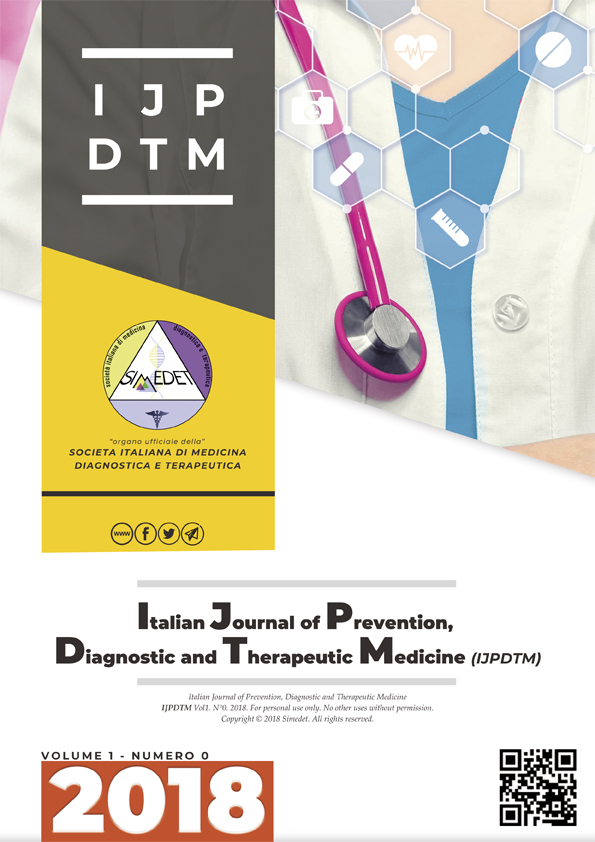The measurement of intra-abdominal pressure in intensive care indications and nursing management
Main Article Content
Abstract
Intra-abdominal pressure (Intra Abdominal Pressure - IAP) is defined as the pressure inside the abdominal cavity at the steady state.
Abdominal hypertension (IHA) is an often underestimated but frequent problem in intensive care; the prevalence of abdominal compartment syndrome (ACS) in the intensive care units ranges from 1 to 15%, while that of intraabdominal hypertension ranges from 2 to 33% depending on the type of patients, the average length of stay and the therapies used.
The pathological increase in intraabdominal pressure has a negative impact on all organs and systems, causing dysfunctionality and insufficiency.
The measurement of IAP allows an early diagnosis of abdominal hypertension, it is a parameter whose monitoring is becoming increasingly widespread in the daily practice of intensive care and beyond.
ACS can develop due to a variety of causes; it is therefore impossible to apply a standardized therapeutic strategy.
However, the following principles are essential for the appropriate management of all patients:
1) serial monitoring of the IAP at least every 4 hours, or more frequently if necessary;
2) optimization of systemic perfusion and organ function in patients with increased IAP;
3) establishment of medical strategies;
4) surgical decompression for refractory ACS.
Specific nursing management for patients with ACS involves the assessment of organ dysfunction and ACS risk factors and the measurement of IAP at regular intervals.
Nursing management of patients with IAH or ACS is particularly complex and requires clinical experience.
It is oriented to guarantee:
• hemodynamic monitoring, assessment of vital signs, filling pressures and signs of perfusion (temperature and color of the extremities);
• pain management;
• from drainage management;
• the water balance;
• Electrolytic and acid-base monitoring;
• Psychological support for patients and their families.
The management of the IAH / ACS and the monitoring of the IAP, due to its clinical implications and its complexity, requires experienced nurses possessing advanced skills, in-depth knowledge, decisionmaking ability and critical thinking.
Downloads
Article Details

This work is licensed under a Creative Commons Attribution-NonCommercial-NoDerivatives 4.0 International License.
References
De Laet IE, Ravyts M, Vidts W, Valk J, De Waele JJ, Malbrain MLNG. Current insights in intra-abdominal hypertension and abdominal compartment syndrome: Open the abdomen and keep it open! Langenbeck’s Arch Surg. 2008;393(6):833–47.
Malbrain MLNG, Chiumello D, Pelosi P, Bihari D, Innes R, Ranieri VM, et al. Incidence and prognosis of intraabdominal hypertension in a mixed population of critically ill patients: a multiple-center epidemiological study. Crit Care Med. 2005;33(2):315–22.
Morken J, West MA. Abdominal compartment syndrome in the intensive care unit. Curr Opin Crit Care . 2001 Aug ;7(4):268–74.
Spencer P, Kinsman L, Fuzzard K. A critical care nurse’s guide to intra abdominal hypertension and abdominal compartment syndrome. Aust Crit Care. 2008;21(1):18–28.
Pasero D, Zanierato M, Braschi A. Significato clinico della pressione intraddominale nel paziente critico. In: Atti XX Riunione Clinico-Scientifica del Dipartimento di Chirurgia. 2003.
Malbrain MLNG, Chiumello D, Pelosi P, Wilmer A, Brienza N, Malcangi V, et al. Prevalence of intra-abdominal hypertension in critically ill patients: A multicentre epidemiological study. Intensive Care Med. 2004;30(5):822–9.
Kirkpatrick AW, Roberts DJ, De Waele J, Jaeschke R, Malbrain MLNG, De Keulenaer B, et al. Intra-abdominal hypertension and the abdominal compartment syndrome: updated consensus definitions and clinical practice guidelines from the World Society of the Abdominal Compartment Syndrome. Intensive Care Med. 2013 Jul 15;39(7):1190–206.
Carlotti APCP, Carvalho WB. Abdominal compartment syndrome: A review. Pediatr Crit Care Med. 2009 Jan;10(1):115–20.
Malbrain MLNG, De laet IE, De Waele JJ, Kirkpatrick AW. Intra-abdominal hypertension: Definitions, monitoring, interpretation and management. Best Pract Res Clin Anaesthesiol . 2013 Jun;27(2):249–70.
Poletti N, Rossi F. La sindrome del compartimento intra-addominale: implicazioni assistenziali ed organizzative nel monitoraggio routinario in terapia intensiva. Scenario. 2008;25(2):35–8.
Malbrain MLNG, De Laet IE, De Waele JJ, Kirkpatrick AW. Intra-abdominal hypertension: Definitions, monitoring, interpretation and management. Best Pract Res Clin Anaesthesiol. 2013;27(2):249–70.
Carlotti, P. APC, Carvalho, Werther B. Abdominal compartment syndrome: A review. Pediatr Crit Care Med. 2009;10(1):115–20.
Soler Morejón CDD, Tamargo Barbeito TO. Effect of mechanical ventilation on intra-abdominal pressure in critically ill patients without other risk factors for abdominal hypertension: an observational multicenter epidemiological study. Ann Intensive Care. 2012;2 Suppl 1(Suppl 1):S22.
Cheatham ML, Malbrain MLNG, Kirkpatrick A, Sugrue M, Parr M, De Waele J, et al. Results from the International Conference of Experts on Intra-abdominal Hypertension and Abdominal Compartment Syndrome. II. Recommendations. Intensive Care Med. 2007 Jun 22;33(6):951–62.
Vasquez DG, Berg-Copas GM, Wetta-Hall R, Burch JM, Moore EE, Moore FA, et al. Influence of semi-recumbent position on intra-abdominal pressure as measured by bladder pressure. J Surg Res. 2007 May 15 ;139(2):280–5.
Cheatham ML, White MW, Sagraves SG, Johnson JL, Block EF. Abdominal perfusion pressure: a superior parameter in the assessment of intra-abdominal hypertension. J Trauma . 2000 Oct ;49(4):621-6-7.
Beck R, Halberthal M, Zonis Z, Shoshani G, Hayari L, Bar-Joseph G. Abdominal compartment syndrome in children. Pediatr Crit Care Med [Internet]. 2001 Jan ;2(1):51–6.
Bailey J, Shapiro MJ. Abdominal compartment syndrome. Crit Care [Internet]. 2000 ;4:23–9.
McNelis J, Marini C SH. Abdominal compartment syn-drome: clinical manifestations and predictive factorsitle. Curr Opin Crit Care. 2003;9(133):6.

